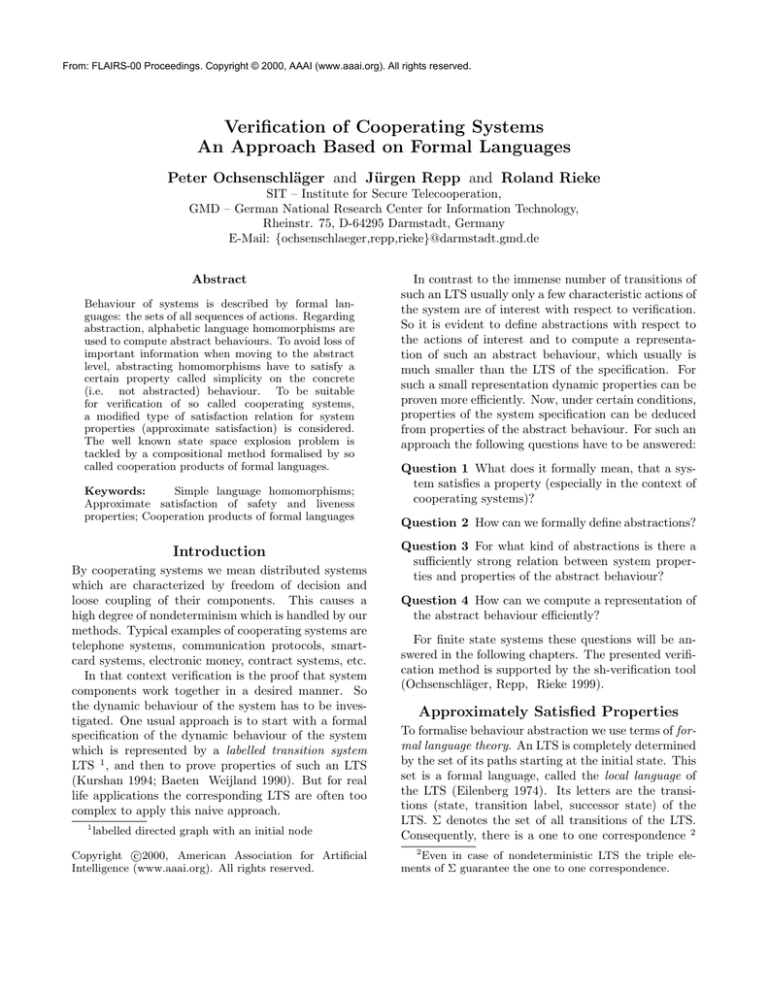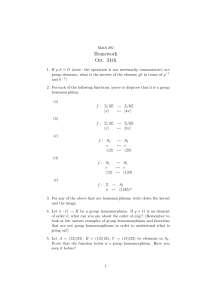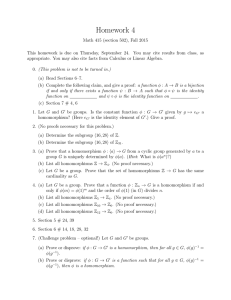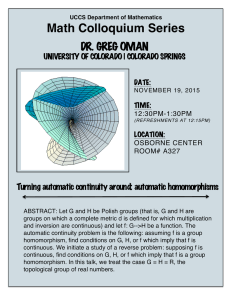
From: FLAIRS-00 Proceedings. Copyright © 2000, AAAI (www.aaai.org). All rights reserved.
Verification of Cooperating Systems
An Approach Based on Formal Languages
Peter Ochsenschläger and Jürgen Repp and Roland Rieke
SIT – Institute for Secure Telecooperation,
GMD – German National Research Center for Information Technology,
Rheinstr. 75, D-64295 Darmstadt, Germany
E-Mail: {ochsenschlaeger,repp,rieke}@darmstadt.gmd.de
Abstract
Behaviour of systems is described by formal languages: the sets of all sequences of actions. Regarding
abstraction, alphabetic language homomorphisms are
used to compute abstract behaviours. To avoid loss of
important information when moving to the abstract
level, abstracting homomorphisms have to satisfy a
certain property called simplicity on the concrete
(i.e. not abstracted) behaviour. To be suitable
for verification of so called cooperating systems,
a modified type of satisfaction relation for system
properties (approximate satisfaction) is considered.
The well known state space explosion problem is
tackled by a compositional method formalised by so
called cooperation products of formal languages.
Keywords:
Simple language homomorphisms;
Approximate satisfaction of safety and liveness
properties; Cooperation products of formal languages
Introduction
By cooperating systems we mean distributed systems
which are characterized by freedom of decision and
loose coupling of their components. This causes a
high degree of nondeterminism which is handled by our
methods. Typical examples of cooperating systems are
telephone systems, communication protocols, smartcard systems, electronic money, contract systems, etc.
In that context verification is the proof that system
components work together in a desired manner. So
the dynamic behaviour of the system has to be investigated. One usual approach is to start with a formal
specification of the dynamic behaviour of the system
which is represented by a labelled transition system
LTS 1 , and then to prove properties of such an LTS
(Kurshan 1994; Baeten Weijland 1990). But for real
life applications the corresponding LTS are often too
complex to apply this naive approach.
1
labelled directed graph with an initial node
c
Copyright 2000,
American Association for Artificial
Intelligence (www.aaai.org). All rights reserved.
In contrast to the immense number of transitions of
such an LTS usually only a few characteristic actions of
the system are of interest with respect to verification.
So it is evident to define abstractions with respect to
the actions of interest and to compute a representation of such an abstract behaviour, which usually is
much smaller than the LTS of the specification. For
such a small representation dynamic properties can be
proven more efficiently. Now, under certain conditions,
properties of the system specification can be deduced
from properties of the abstract behaviour. For such an
approach the following questions have to be answered:
Question 1 What does it formally mean, that a system satisfies a property (especially in the context of
cooperating systems)?
Question 2 How can we formally define abstractions?
Question 3 For what kind of abstractions is there a
sufficiently strong relation between system properties and properties of the abstract behaviour?
Question 4 How can we compute a representation of
the abstract behaviour efficiently?
For finite state systems these questions will be answered in the following chapters. The presented verification method is supported by the sh-verification tool
(Ochsenschläger, Repp, Rieke 1999).
Approximately Satisfied Properties
To formalise behaviour abstraction we use terms of formal language theory. An LTS is completely determined
by the set of its paths starting at the initial state. This
set is a formal language, called the local language of
the LTS (Eilenberg 1974). Its letters are the transitions (state, transition label, successor state) of the
LTS. Σ denotes the set of all transitions of the LTS.
Consequently, there is a one to one correspondence 2
2
Even in case of nondeterministic LTS the triple elements of Σ guarantee the one to one correspondence.
between the LTS and its local language L ⊂ Σ∗ , where
Σ∗ is the set of all sequences of elements of Σ including the empty sequence . Now behaviour abstraction can be formalized by language homomorphisms,
more precisely by alphabetic language homomorphisms
h : Σ∗ → Σ0∗ (answer to question 2). By these homomorphisms certain transitions are ignored and others are renamed, which may have the effect, that different transitions are identified with one another. A
mapping h : Σ∗ → Σ0∗ is called a language homomorphism if h() = and h(yz) = h(y)h(z) for each
y, z ∈ Σ∗ . It is called alphabetic, if h(Σ) ⊂ Σ0 ∪ {}.
An automaton representation (minimal automaton)
(Eilenberg 1974) for the abstract behaviour of a specification (homomorphic image of the LTS’s local language) can be computed by the sh-verification tool.
The usual concept of linear satisfaction of properties
(each infinite run of the system satisfies the property)
is not suitable in this context because no fairness constraints are considered. We put a very abstract notion of fairness into the satisfaction relation for properties, which considers that independent of a finitely
long computation of a system certain desired events
may occure eventually . To formalise such “possibility properties”, which are of interest when considering
what we call cooperating systems, the notion of approximate satisfaction of properties is defined in (Nitsche
Ochsenschläger 1996) (answer to question 1):
Definition. An LTS approximately satisfies a property if and only if each finite path can be continued to
an infinite path, which satisfies the property.
As it is well known, system properties are divided
into two types: safety (what happens is not wrong)
and liveness properties (eventually something desired
happens) (Alpern Schneider 1985). For safety properties linear satisfaction and approximate satisfaction
are equivalent (Nitsche Ochsenschläger 1996). Examples are given in (Ochsenschläger, Repp, Rieke 1999).
The notion of approximate satisfaction is related to
machine-closure as defined in (Apt, Frances, Katz
1988).
Simple Homomorphisms as an
Abstraction Concept
It is now the question of main interest, whether, by
investigating an abstract behaviour, we may verify the
correctness of the underlying concrete behaviour. Generally under abstraction the problem occurs, that an
incorrect subbehaviour can be hidden by a correct
one. We will answer this question positively, requiring a restriction of the permitted abstraction techniques. To deduce approximately satisfied properties
of a specification from properties of its abstract be-
haviour an additional property of abstractions is required: called simplicity of homomorphisms on a specification (Ochsenschläger 1992). Simplicity of homomorphisms on specifications is a very technical condition concerning the possible continuations of finite
behaviours.
Concerning abstractions h : Σ∗ → Σ0∗ the crucial point are the liveness properties of a language
L ⊂ Σ∗ . To define simplicity formally we need
w−1 (L) = {y ∈ Σ∗ |wy ∈ L} , the set of continuations
of a word w in a language L (Eilenberg 1974). These
continuations in some sense “represent” the liveness
properties of L. Generally h(x−1 (L)) is a (proper)
subset of h(x)−1 (h(L)) , but we want to have that
h(x−1 (L)) “eventually” equals h(x)−1 (h(L)) .
Definition. A homomorphism h is called simple on
L, if for each x ∈ L there exists w ∈ h(x)−1 (h(L))
such that w−1 (h(x−1 (L))) = (h(x)w)−1 (h(L)) .
For regular languages simplicity is decidable, but by
a very complex algorithm. In (Ochsenschläger 1992;
1994) a sufficient condition based on the strongly connected components of an LTS has been proven.
Theorem. Let L be a language recognized by a finite
automaton A and let h be a homomorphism on L. If
for each x ∈ L there exists y ∈ x−1 (L) leading to a
dead component 3 of A , such that each z ∈ L with
h(z) = h(xy) leads to the same dead component, then
h is simple on L.
This condition is satisfied for example, if each dead
component contains a label a of an edge with h(a) 6= ,
such that no edge exists outside of this component,
whose label has the same image h(a). If A is strongly
connected, then each homomorphism is simple on L. In
(Ochsenschläger 1992; 1994) also a necessary condition
for simplicity has been proven.
The following theorem (Nitsche Ochsenschläger
1996) shows that approximate satisfaction of properties and simplicity of homomorphisms exactly fit together for verifying cooperating systems (answer to
question 3):
Theorem. Simple homomorphisms define exactly
the class of such abstractions, for which holds that each
property is approximately satisfied by the abstract behaviour if and only if the “corresponding“ property is
approximately satisfied by the concrete behaviour of the
system.
Formally, the “corresponding“ property is expressed
by the inverse image of the abstract property with respect to the homomorphism.
Our verification method, which is based on the very
general notions of approximate satisfaction of properties and simple language homomorphisms, does not de3
a component without outgoing edges
pend on a specific formal specification method. It can
be applied to all specification techniques with an LTS
semantics.
X
A Compositional Approach to Avoid
State Space Explosion
Simple homomorphisms establish the coarsest, i.e.
most abstract notion of system equivalence with respect to a given (abstract) requirement specification.
In some sense this equivalence is weaker than failure equivalence (Baeten Weijland 1990), which is too
strong in the context of cooperationg systems, as it is
shown in (Ochsenschläger 1994). What still remains
open is the question of how to construct an abstract
behaviour to a given specification without an exhaustive construction of its state space.
To handle the well known state space explosion
problem, a compositional method has been developed
(Ochsenschläger 1996) and implemented in the shverification tool. In case of well structured specifications, by applying a divide and conquer strategy
this method allows to compute a representation of the
abstract behaviour and to check simplicity of homomorphisms efficiently without having to compute the
complex LTS of the complete specification (answer to
question 4). This compositional method is combined
with a partial order method based on partially commutative languages (Ochsenschläger 1997).
The main goal of our compositional method is to
compute minimal automata of homomorphic images
and to check simplicity of homomorphisms efficiently
even in case of complex specifications. The fundamental idea is to embed each component of a structured
system (X and Y in Figure 4) in a “simplified environment“ (Y’ and X’ in Figure 1), which shows at the interface an “equivalent behaviour“ compared to the rest
of the system (shaded areas in Figure 1). This can be
checked using special homomorphisms, called boundary homomorphisms. The complexity of this check is
reduced by our partial order method.
For each of these smaller systems minimal automata
related to corresponding homomorphisms (which have
to be finer than the boundary homomorphisms) are
computed (Figure 2) and are composed (Figure 3) to
obtain the desired automaton (Figure 4).
Composition of system behaviour is formalised by
the notion of cooperation products of formal languages,
a restricted kind of shuffle product (Eilenberg 1974).
Simplicity of homomorphisms on cooperation products
is guaranteed by a particular property of the boundary homomorphisms, which is called cooperativity. For
more details we refer to (Ochsenschläger et al. 1998).
Y’
X’
Y
Figure 1:
X
Y’
X’
Y
Figure 2:
Figure 3:
X
Y
Figure 4:
Cooperation Products
Cooperation products of formal languages describe behaviour of composed systems in terms of their components behaviour and of the communication systems
behaviour. To express specific properties of a communication system cooperation products are more flexible
than rendezvous (Baeten Weijland 1990), as they are
used in algebraic specification techniques.
As an example let us consider a system that consists
of a client and a server as its main components. The
client sends requests to the server, expecting the server
to produce particular results. Nevertheless, for some
reasons, the server may not always respond a request
by sending a result, but may, as well, reject a request.
The clients and servers behaviour is given in Figure 5
and Figure 6. The initial states are shaded.
As the clients and servers LTS is deterministic, it is sufficient to consider the transition labels instead of the triples (state,transition label,
c_RES
c_REJ
c_REQ
d_REQ
Figure 5: Client Behaviour
a_REQ
a_RES
d_REJ
s_REJ
d_RES
s_REQ
a_REJ
Figure 7: Communication System
s_RES
s1
s2
s4
s3
s_REQ
munication system we use alphabetic homomorphisms
φ : Φ∗ −→ Σ∗ and γ : Γ∗ −→ Σ∗ defined by
φ(c REQ) = a REQ, φ(c RES) = d RES,
φ(c REJ) = d REJ and
γ(s REQ) = d REQ, γ(s RES) = a RES,
s_REJ
Figure 6: Server Behaviour
succ.
state) as the corresponding actions.
So
the clients behaviour is described by a formal language F ⊂ Φ∗ with Φ = {c REQ, c RES, c REJ}
and the servers behaviour by G ⊂ Γ∗ with Γ =
{s REQ, s RES, s REJ, s1, s2, s3, s4}. F and G are
the languages accepted by the automata of Figure 5
and Figure 6, where all states are accepting states.
By usual interleaving semantics (Baeten Weijland
1990) the global system behaviour is described by a
language L ⊂ (Φ∪Γ)∗ with πΦ (L) ⊂ F and πΓ (L) ⊂ G,
where πΦ : (Φ ∪ Γ)∗ −→ Φ∗ and πΓ : (Φ ∪ Γ)∗ −→ Γ∗
are homomorphisms defined by πΦ (x) = x for x ∈
Φ, πΦ (x) = for x ∈ Γ, πΓ (x) = for x ∈ Φ and
πΓ (x) = x for x ∈ Γ. Notice that Φ ∩ Γ = ∅, which
is generally assumed to define the cooperation product
of F and G.
The global behaviour L not only depends on F and
G but also on the kind of communication. For example
let us consider a common buffer of capacity 1. The
behaviour of this communication system is given in
Figure 7.
The label a M means accepting a message M
and d M means delivering message M . This automaton defines a language C ⊂ Σ∗ with Σ =
{a REQ, d REQ, a RES, d RES, a REJ, d REJ}.
To formally express F 0 s and G0 s “effect” on the com-
γ(s REJ) = a REJ,
γ(s1) = γ(s2) = γ(s3) = γ(s4) = .
With these homomorphisms L has to satisfy the condition [φ, γ](L) ⊂ C, where [φ, γ] : (Φ ∪ Γ)∗ −→ Σ∗
is the homomorphism defined by [φ, γ](x) = φ(x) for
x ∈ Φ and [φ, γ](x) = γ(x) for x ∈ Γ.
Now the tree conditions πΦ (L) ⊂ F, πΓ (L) ⊂ G and
[φ, γ](L) ⊂ C together completely define the global
−1
behaviour: L = πΦ
(F ) ∩ πΓ−1 (G) ∩ [φ, γ]−1 (C).
−1
Definition. [F, G]c = πΦ
(F ) ∩ πΓ−1 (G) ∩ [φ, γ]−1 (C)
is called the cooperation product of F and G with
respect to c = (Φ, Γ, Σ, φ, γ, C).
In (Ochsenschläger et al. 1998) this example is
discussed in more detail.
Using cooperation products the notion of cooperativity
is formulated in (Ochsenschläger 1996), which gives a
sufficient condition for simplicity of homomorphisms
on cooperation products. The automata pendant to cooperation products are asynchronous product automata
(APA), as they are defined in (Ochsenschläger 1996;
Ochsenschläger et al. 1998). It is a very general class
of communicating automata. APA can be regarded
as families of automata (elementary automata), whose
sets of states are cartesian products and whose elementary automata are “glued together” by common
components of these products. In (Ochsenschläger et
al. 1998) our compositional method is formulated in
terms of APA.
Conclusions
We have presented a verification method which comprises a satisfaction relation with an inherent fairness
assumption and an abstraction concept adequate for
the particular, practically useful satisfaction relation.
Our approach, which is based on the very general notions of approximate satisfaction of properties and simple language homomorphisms, does not depend on a
specific formal specification method. It can be applied
to all those specification techniques having an LTSsemantics.
Summarizing, using simple abstractions and approximate satisfaction verification can be done in two ways:
• System properties are explicitly given by temporal
logic formulae or Büchi-automata. They can be
checked on the abstract behaviour (under a simple
homomorphism).
• Specifications of different abstraction levels are compared by corresponding simple homomorphisms. In
that case system properties are given implicitly.
The presented approach can be compared with automata based methods as described in (Alur Henzinger
1995) or (Kurshan 1994) as well as with the concurrency workbench (Cleaveland, Parrow, Steffen 1993),
which uses the modal µ-calculus. We consider the main
strength of our method to be the combination of an inherent fairness assumption in the satisfaction relation,
a very flexible abstraction technique compatible with
approximate satisfaction, and a suitable compositional
and partial order method for the construction of only
a partial state space.
Though our method has been developed for finite
state systems we think that it also can be applied to
infinite state systems. For that purpose it has to be
combined with a theorem prover.
Our recent interest is focused on the verification of
binding cooperations like electronic money and contract systems (Grimm Ochsenschläger 1999). In that
context the use of cooperation products leads to formal
requirement specifications for cryptographic protocols.
References
Alpern, B., and Schneider, F. B. 1985. Defining liveness. Information Processing Letters 21(4):181–185.
Alur, R., and Henzinger, T. A. 1995. Local liveness
for compositional modeling of fair reactive systems. In
Wolper, P., ed., Computer Aided Verification (CAV)
’95, volume 939 of Lecture Notes in Computer Science, 166–179. Springer.
Apt, K.; Frances, N.; and Katz, S. 1988. Appraising fairness in languages for distributed programming.
Distributed Computing 2:226–241.
Baeten, J., and Weijland, W. 1990. Process Algebra.
Cambridge University Press.
Cleaveland, R.; Parrow, J.; and Steffen, B. 1993. The
concurrency workbench: A semantics-based tool for
the verification of finite-state systems. In TOPLAS
15, 36–72.
Eilenberg, S. 1974. Automata, Languages and Machines, volume A. New York: Academic Press.
Grimm, R., and Ochsenschläger, P.
1999.
Verbindliche Telekooperation. Ein Modell für Electonic Commerce auf Basis formaler Sprachen. In
Röhm, Fox, G. S., ed., Sicherheit und Electronic
Commerce. DuD-Fachbeiträge, 1–14. Braunschweig,
Wiesbaden: Vieweg.
Kurshan, R. P. 1994. Computer-Aided Verification
of Coordinating Processes. Princeton, New Jersey:
Princeton University Press, first edition.
Nitsche, U., and Ochsenschläger, P. 1996. Approximately satisfied properties of systems and simple language homomorphisms. Information Processing Letters 60:201–206.
Ochsenschläger, P.; Repp, J.; Rieke, R.; and Nitsche,
U. 1998. The SH-Verification Tool – AbstractionBased Verification of Co-operating Systems. Formal
Aspects of Computing 10:381–404.
Ochsenschläger, P.; Repp, J.; and Rieke, R. 1999.
The SH-Verification Tool. Submitted to FLAIRS2000 Special Track on Validation, Verification & System Certification.
Ochsenschläger, P. 1992. Verifikation kooperierender Systeme mittels schlichter Homomorphismen. Arbeitspapiere der GMD 688, Gesellschaft für Mathematik und Datenverarbeitung (GMD), Darmstadt.
Ochsenschläger, P. 1994. Verification of cooperating
systems by simple homomorphisms using the product
net machine. In Desel, J.; Oberweis, A.; and Reisig,
W., eds., Workshop: Algorithmen und Werkzeuge für
Petrinetze, 48–53. Humboldt Universität Berlin.
Ochsenschläger, P. 1996. Kooperationsprodukte formaler Sprachen und schlichte Homomorphismen. Arbeitspapiere der GMD 1029, GMD – Forschungszentrum Informationstechnik, Darmstadt.
Ochsenschläger, P.
1997.
Schlichte Homomorphismen auf präfixstabilen partiell kommutativen
Sprachen. Arbeitspapiere der GMD 1106, GMD –
Forschungszentrum Informationstechnik, Darmstadt.




